Diversity Collection
Maintenance
To open the maintenance form choose Administration -









With the button 

To open the maintenance form choose Administration -









With the button 

With the maintenance functions you can update values cached from other
modules or external webservices. DiversityCollection can be linked with
several other modules of the DiversityWorkbench. If you link a data
source to another module, the URI of the data set in the other module
together with one or several cached values will be stored in
DiversityCollection. Due to changes in the source modules these cached
values may differ from the original values. To get the actual values you
can use the 


To synchronize the entries derived from the module DiversityGazetteer
choose Administration → Maintenance from the menu. A window will
open as shown below. On the tab page 

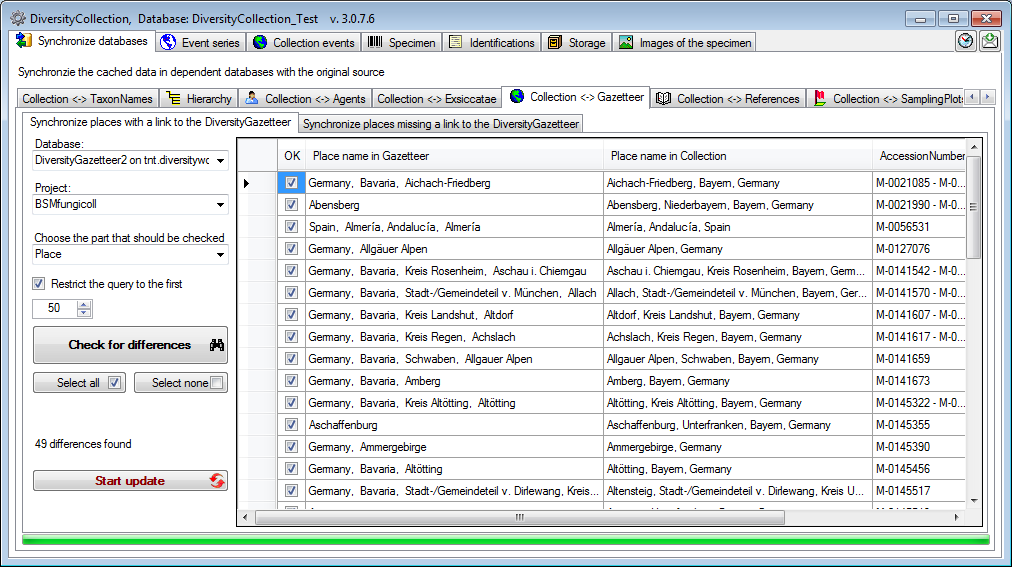
The form will list all detected differences. To update the database
click on the Start update 
To set links to the DiversityGazetteer for places which are not linked
so far choose the second tab under Collection <→ Gazetteer for
synchronization of places missing a connection to the
DiversityGazetteer. Choose the database and the project and click on the


Many places have identical names in different regions. Names where
several results were found are marked in blue. To choose the correct
name among the list of results, click on the  Select valid place button and select the correct name from the list
as shown below.
Select valid place button and select the correct name from the list
as shown below.
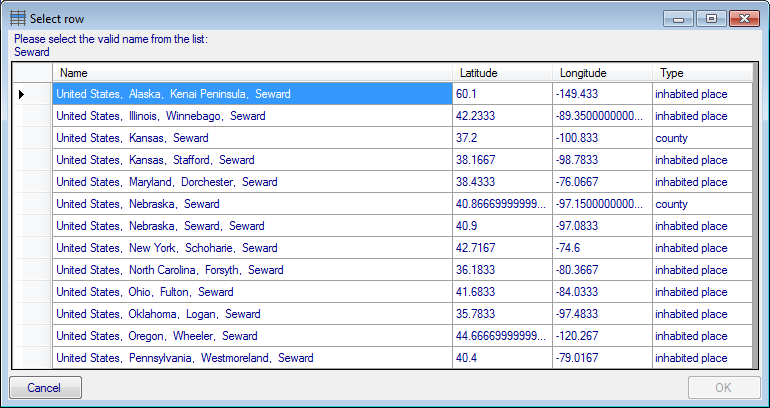
Finally, click on the 
Taxonomic names may be linked to an external source. To synchronize the entries for the taxonomic names derived from the module DiversityTaxonNames choose Administration → Maintenance… from the menu. A window will open as shown below. Choose the tab TaxonNames. There are two ways to synchronize taxonomic names. You may either Synchronize taxonomic names based on the link via an URI for entries where the link to a taxonomic database is already established or you may Synchronize taxonomic names missing a connection where no link is established and you can query for identical names in one of the databases.
The taxonomic names are stored in the field TaxonomicName in the table
Identification. Select a
taxonomic database and a project and taxonomic group which should be
synchronized. Start the query with a click on the Check for
differences 
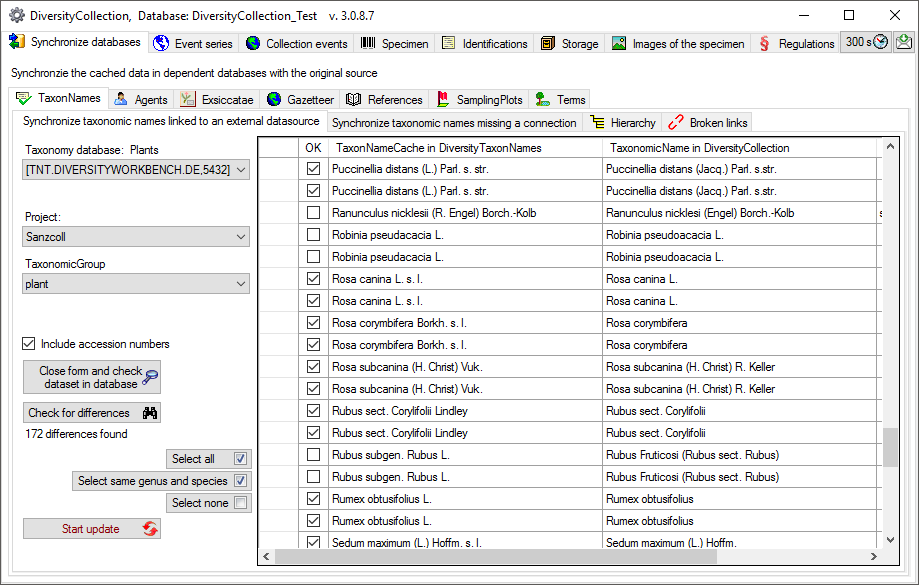
If the taxonomic information has been imported into the

The form will list all differences found. With the Select same genus and species 


To update the database click on the Start
update 

Select a taxonomic database and a project within this database, a project in the collection database and a taxonomic group to search for identical names. Start the query with a click on the Check for identical names button. You have several options to search for fitting names:
Search for an exact match. With the option 
Search for names fitting in first parts of the name as shown below. If
the names do not match exactly, you may either update the name (


If you choose the option 
If you choose the option 
In the result list only matching names will be checked (column OK). The other results will be marked indicating the difference.
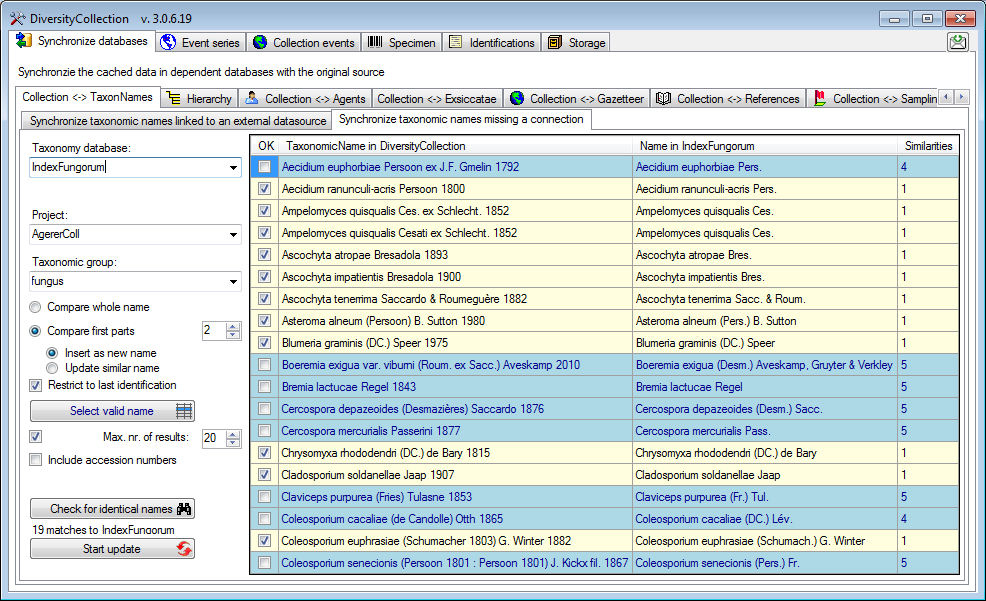
If several similar names were found, these lines will be
marked with a blue background. To select one of the similar names click
on the Select valid name  button. A window
will open as shown below listing all similar names found in Index
Fungorum. Select one name and click OK to use it.
button. A window
will open as shown below listing all similar names found in Index
Fungorum. Select one name and click OK to use it.
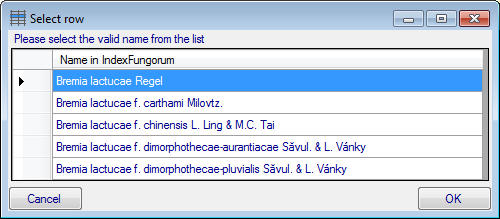
If for any reason links to webservices or modules are broken  , e.g. when a webservice changes its address, you can search for these (see below).
Please make sure, that you are connected with all
source databases used for the taxa. Otherwise connections to these
sources would be assumed as broken. Choose the Project, for which
you want to search for broken links and optional restrict the search on
a Source and a Taxonomic group. Click on the
, e.g. when a webservice changes its address, you can search for these (see below).
Please make sure, that you are connected with all
source databases used for the taxa. Otherwise connections to these
sources would be assumed as broken. Choose the Project, for which
you want to search for broken links and optional restrict the search on
a Source and a Taxonomic group. Click on the

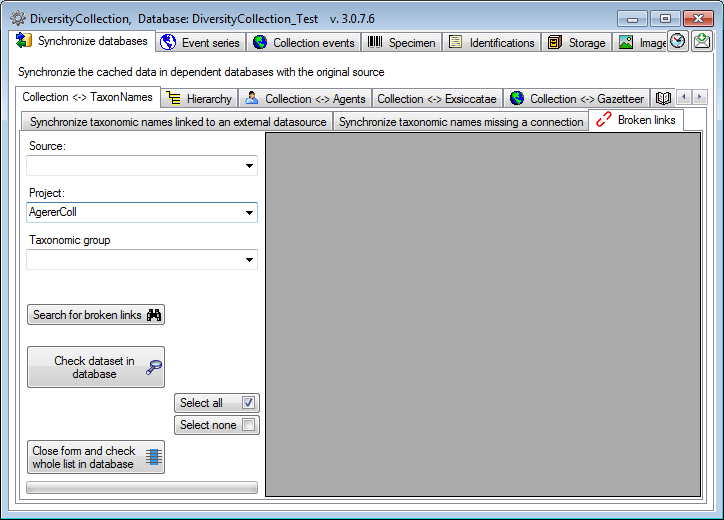
The broken links will be listed as shown below. With the Check dataset
in database 



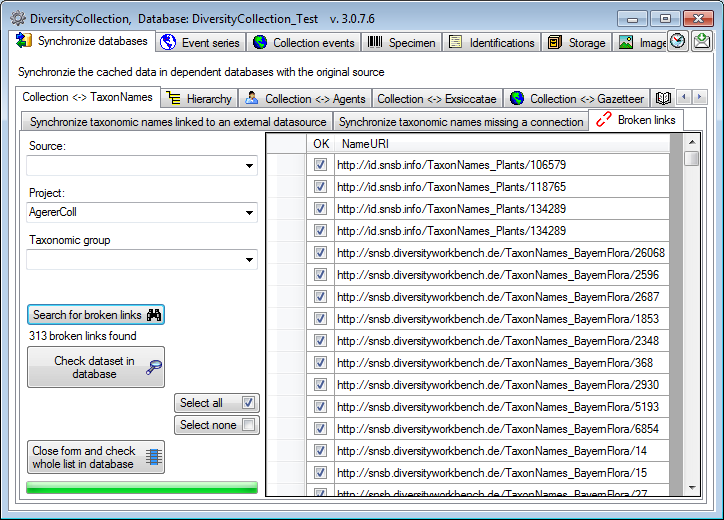
If for any reason the displayed text for an organism does not correspond
to the last identification, this can be fixed under the Synchronize
last identification tab. Just click on the Search
for organisms where the displayed text does not correspond to the last
identification 

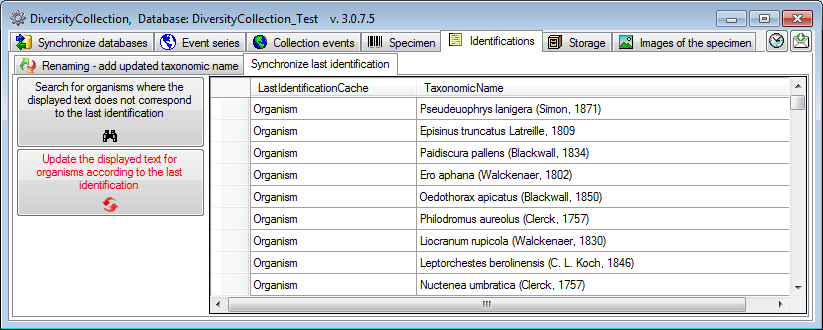
To synchronize the entries for the family, order and hierarchy of taxa
derived from the module DiversityTaxonNames choose Administration →
Maintenance from the menu. A window will open as shown below. To
synchronize the higher taxonomic entries for entries linked to the
module DiversityTaxonNames choose the tab 
Select a taxonomic database, a project and a taxonomic group and then
choose whether you wish to synchronize the family, order or hierarchy.
If you wish to inspect single data sets you need to check the Include
accession number checkbox. Then click on the Check for differences 
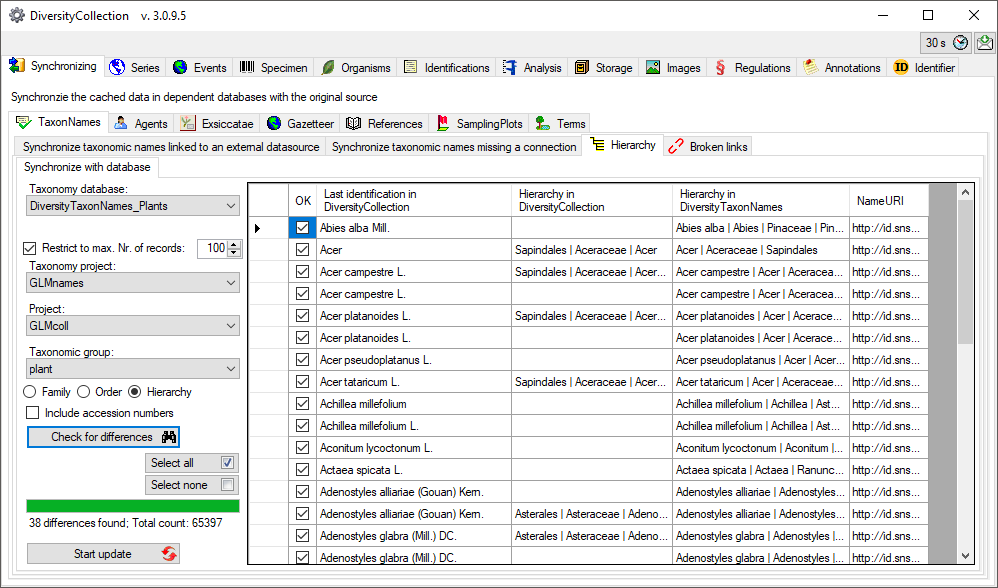
The form will list all differences found as shown above. To update the
database click on the Start update

If you wish to add updated taxonomic names for specimen in the database, you can use the bulk insert function. Choose the project, the taxonomic group and the taxonomic name for which the new identification should be added. As shown in the window below you may enter additional information about this identification. By default the Only last identification option is checked to prevent you from searching in older identifications. If you uncheck this option, the program will search for any identification, irrespective whether it is the last or an older identification.
If you wish to check single data sets check the Include accession numbers option. A new button will appear

which will enable you to close the window and turn to a specimen selected in the table.
To search for names click on the Test button. The found names will be listed in the table as shown below. To insert the new identification click the Start insert button.

If you wish to add 
Click on the Search for accepted names 

If some of the names should not be added, deselect them as shown for the
3. name in the example below. To select or deselect all names you can
use the All 


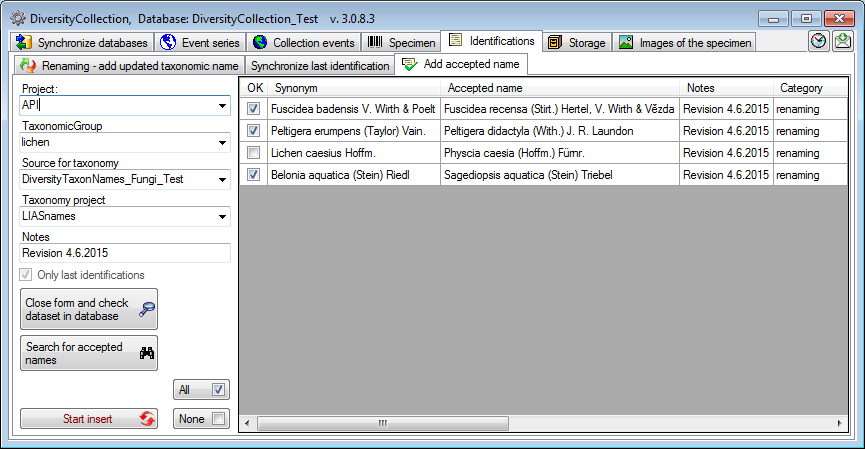
Vernacular terms may be linked to an external source. To synchronize the entries for the terms derived from the module DiversityScientificTerms choose Administration → Maintenance… from the menu. A window will open as shown below. In the Synchronize databases tab choose the tab Identification terms. There are two ways to synchronize scientific terms. You may either Synchronize terms based on the link via an URI for entries where the link to a scientific terms database is already established or you may Synchronize terms missing a connection where no link is established and you can query for identical terms in one of the databases.
The terms are stored in the field VernacularTerm in the table
Identification. Select a
database containing scientific terms, a project and the group which
should be synchronized. Finally you have to decide which part should be
synchronized, either the term or the hierarchy where the hierarchy is
available in two variants (upwards or downwards). Start the query with a
click on the Check for differences 

The form will list all differences found. The other buttons will either
select all 

To update the database click on the Start
update 

Select a database containing scientific terms from the list and a terminology within this database, a project in the collection database and a group to search for identical terms. For the hierarchy you can choose between the hierarchy from the term upwards to superior terms resp. the hierarchy from the top term to the selected term. Start the query with a click on the Check for identical terms button.
In the result list only terms with a single match will be checked (column OK).
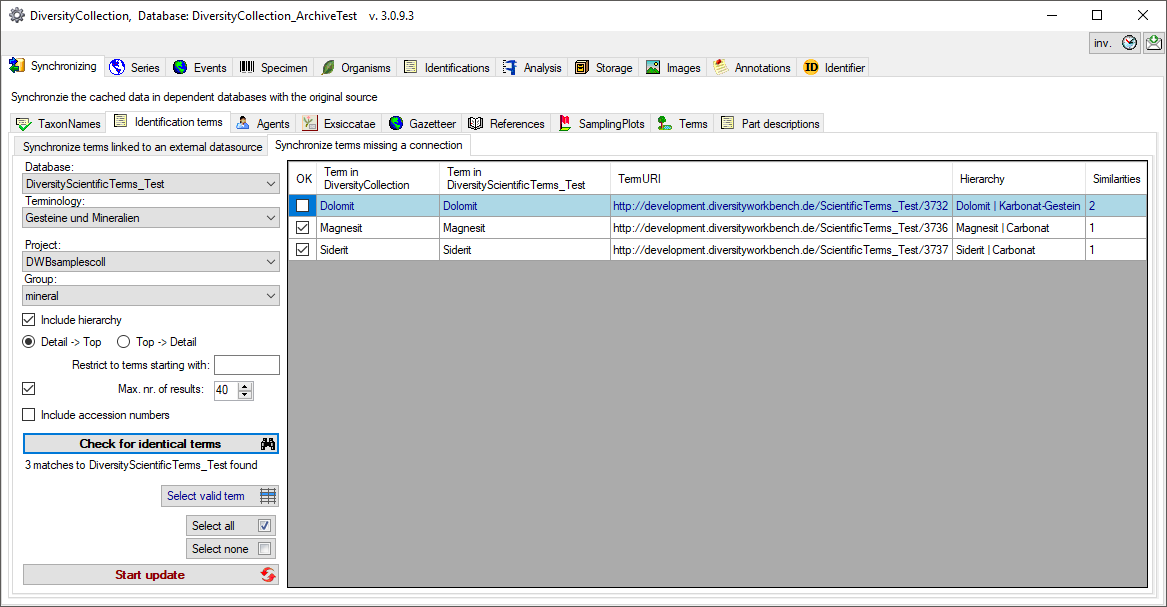
If several similar terms were found, these lines will be
marked with a blue background. To select one of the similar terms click
on the Select valid term  button. A window
will open as shown below listing all similar terms found. Select one
term and click OK to use it.
button. A window
will open as shown below listing all similar terms found. Select one
term and click OK to use it.

To synchronize the entries with the module ScientificTerms choose
Administration → 


To synchonize the content for linked data
select the database, the project, the table and the target for
which the entries should be synchronized. There are 2 targets for the
synchronization: The term itself and the hierarchy. There are 3 tables
which may contain links to DiversityScientificTerms:



To synchronize 


To include the hierarchy in the comparision, check the






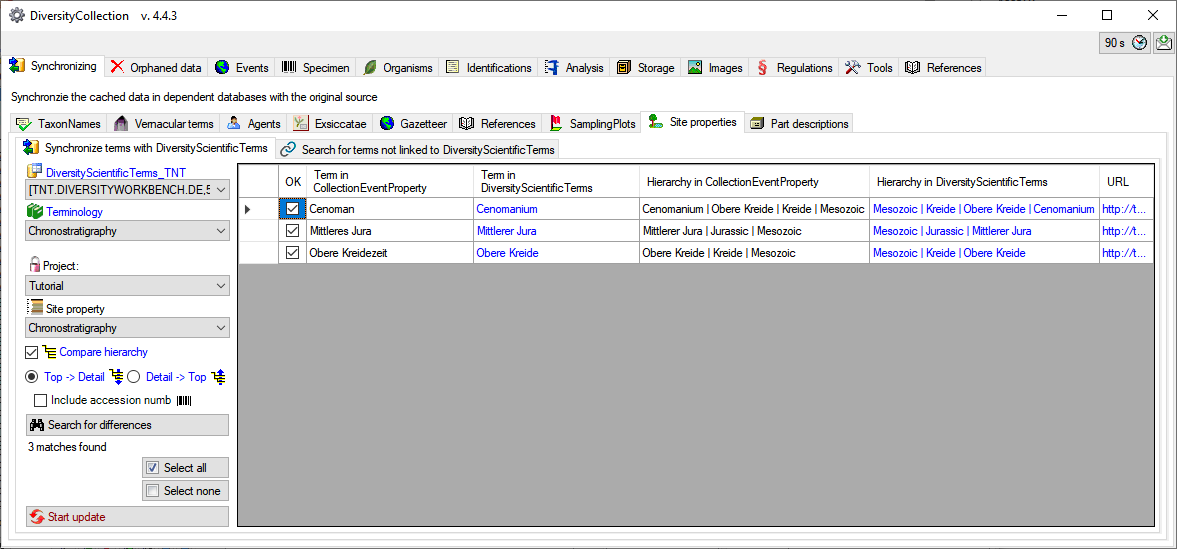
To establish new connections 


As with the query for linked data, you may include the hierarchy. In
addition there are two options to restrict the search:







In the result list you can select the data that should be included in
the update in the first column (OK 



To synchronize the names of collectors, determinators etc. which are
linked to the module DiversityAgents choose Administration -
Maintenance from the menu. A window will open as shown below. On the
tab page Collection <→ Agents select the project for which the
agents should be synchronized. There are 9 tables which may contain
links to DiversityAgents:
Collection,
CollectionAgent,
CollectionEventLocalisation,
CollectionEventProperty,
CollectionSpecimen,
CollectionSpecimenProcessing,
Identification,
IdentificationUnitAnalysis
and Transaction. Choose one of
these tables for the synchronization. Then start the query with a click
on the  button. The type name is written
as defined by the default display type in the module DiversityAgents -
for more information please see the documentation on DiversityAgents.
button. The type name is written
as defined by the default display type in the module DiversityAgents -
for more information please see the documentation on DiversityAgents.
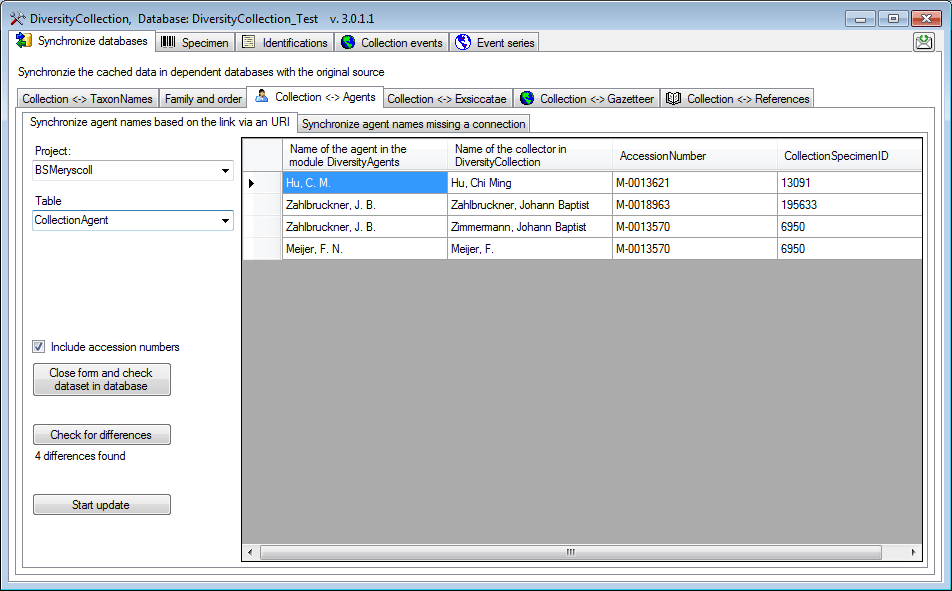
The form will list all differences found. To update the database click
on the  button. If you wish to have a more
detailed look on one of the data sets in the list, you need to check the
“Include accession number” checkbox before starting the query. A button
button. If you wish to have a more
detailed look on one of the data sets in the list, you need to check the
“Include accession number” checkbox before starting the query. A button
 will appear which will take you back to a
single data set in the database.
will appear which will take you back to a
single data set in the database.
You can either update the cached names for entries which are linked to
DiversityAgents as described above or you can search for possible links
based on the names as shown below. In addition to the options described
above you may choose the display type for the query to find any possible
match as names may be written like “Hertel, H.”, “H. Hertel” etc.

Next to a search for identical names you can search for similar names.
Enter a search string in the
Like field and click on the 
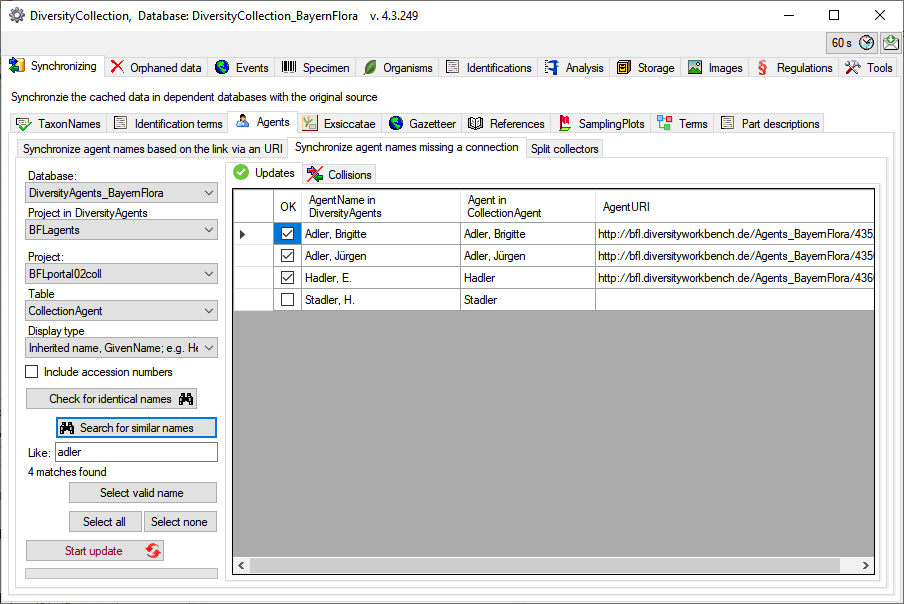
For those dataset where there are more than 1 possible link in the
DiversityAgents database you have to choose the correct link with a
click on the Select valid
names button. A window as shown below will open, where you can
select the valid name. Click on the 
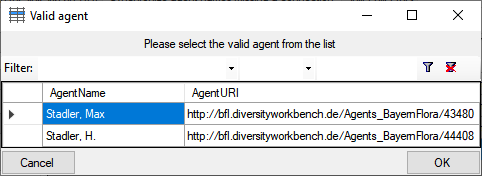
The dataset where the update collides with existing data will be listed
in the tab. Use the

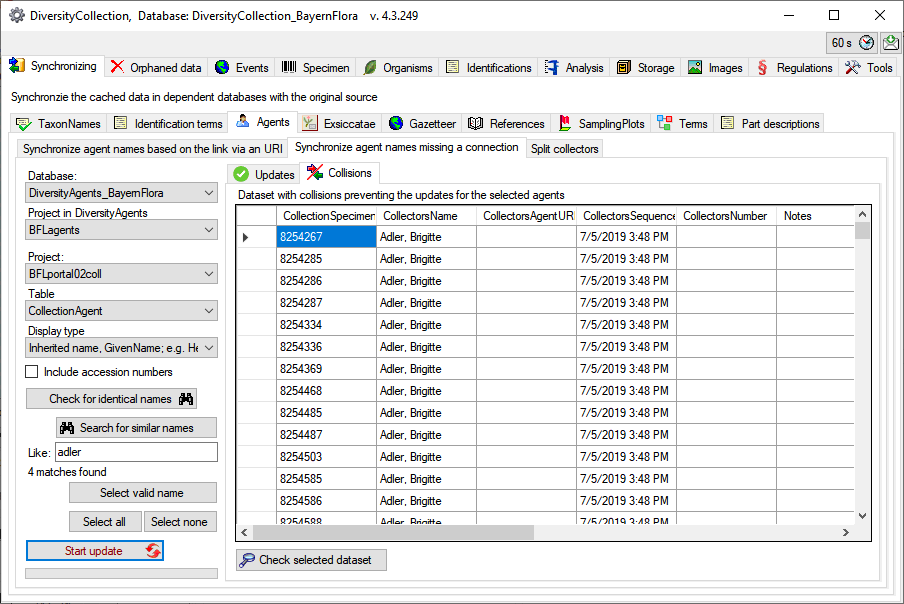
If the collectors had been written in one field with separators like &
you can split these to create a separate entry for every collector (see
below). Choose the project, enter the separator or select one of the
predefined separators and click on the 

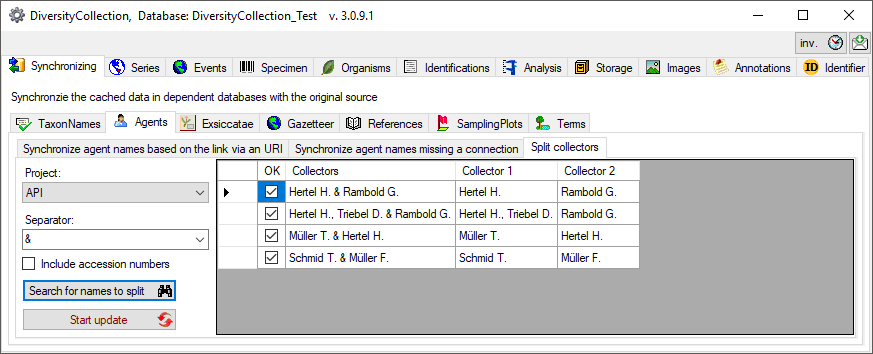
The dataset where the split collides with existing data will be listed
in the tab. Use the


To synchronize the entries derived from the module DiversityScientificTerms choose → from the menu. On the tab page - - .
Select the 



Options:
 Compare hierarchy:
Compare hierarchy:
Click on the button to start the query. To select or deselect the data that should be updated you can use the buttons
With the button you can synchronize the selected datasets
To search for data that are not linked to the module DiversityScientificTerms choose → from the menu. On the tab page - - .
Select the containing the data, the , the 


Options:
 Include hierarchy:
Include hierarchy:
Click on the button to start the query. To select or deselect the data that should be updated you can use the buttons
With the button you can synchronize the selected datasets
To synchronize the abbreviations of the exsiccatal series titles which
are linked to the module DiversityExsiccatae choose Administration →
Maintenance… from the menu. A window will open as shown below. On
the tab page Collection <→ Exsiccatae select the project for
which the titles should be synchronized. The title is stored in the
field ExsiccataAbbreviation in the table
CollectionSpecimen. Select
the project which should be synchronized and start the query by clicking
on the  button.
button.

The form will list all differences found. To update the database click
on the  button. If you wish to have a more
detailed look at your data, you need to check the “Include accession
number” checkbox before starting the query. A button
button. If you wish to have a more
detailed look at your data, you need to check the “Include accession
number” checkbox before starting the query. A button
 will appear which will take you back to a
single data set in the database.
will appear which will take you back to a
single data set in the database.
To synchronize the entries derived from the module
DiversitySamplingPlots choose Administration → Maintenance from
the menu. A window will open as shown below. On the tab page
Collection → SamplingPlots select the project for which the
entries should be synchronized. There are 2 targets for the
synchronization: The plot identifier (as stored in the field Location1), the Geography and
the cached coordinates in table
CollectionEventLocalisation.
Select the project, one of targets for the synchronization and the
DiversitySamplingPlots database. To start the query click on the
 button.
button.
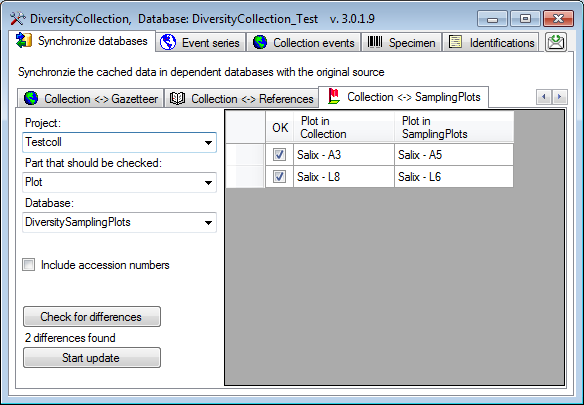
The form will list all differences found. With the first column (OK) you
may deselect certain entries which you do not wish to change. To update
the database click on the  button. If you wish
to have a more detailed look on your data, you need to check the
Include accession number checkbox before starting the query. A
button
button. If you wish
to have a more detailed look on your data, you need to check the
Include accession number checkbox before starting the query. A
button  will appear which will take you back
to a single data set in the database.
will appear which will take you back
to a single data set in the database.
To synchronize the titles of the references which are linked to the
module DiversityReferences choose Administration → Maintenance
from the menu. A window will open as shown below. On the tab page
Collection <→ References select the project for which the
reference titles should be synchronized. With the first option you can

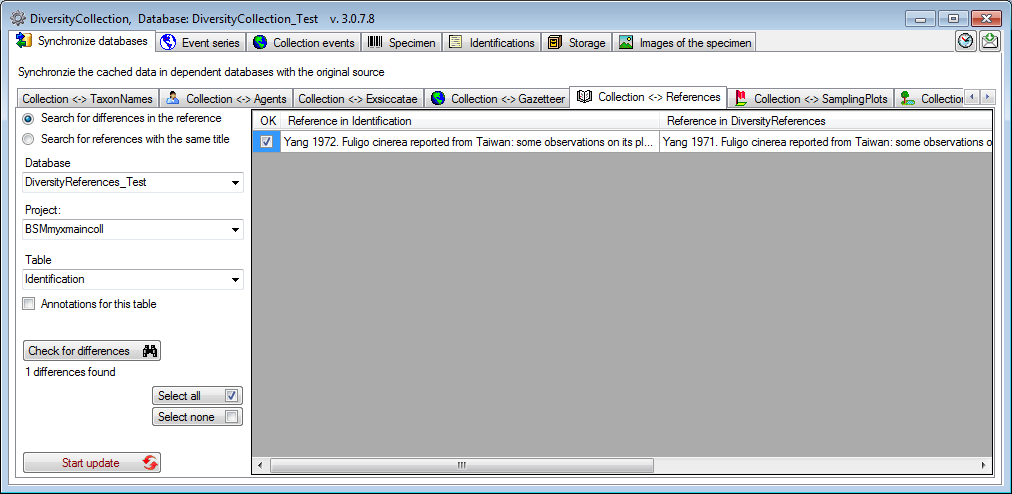
The form will list all differences found. To update the data click on
the Start update

As a second option you can 
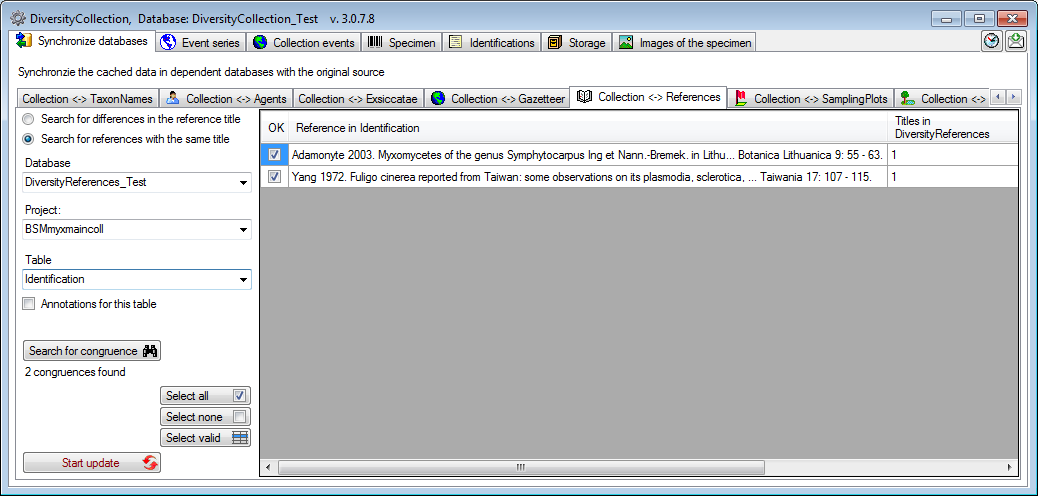
If there is more than 1 reference matching the entry in
DiversityCollection, select the line and click on the Select valid
 button to choose the correct reference.
button to choose the correct reference.
Next to the references in the tables mentioned above, you can perform
the same checks for references stored in the table
Annotation related to the tables
CollectionEvent,
CollectionSpecimen,
CollectionSpecimenPart
and IdentificationUnit. To
use this option, check 

The removal of certain data may leave orphaned data as shown in the
image below. The removal of a specimen may leave event data without any
relation to a specimen. As the access to the data is organized via
projects this relation is removed as well. So orphaned data are
accessible by anyone. Orphaned data may on the other hand exist due to
the preparation of events for upcoming expeditions and the like.
Therefore care should be taken when removing orphaned data to not remove
preparations of other users. For an overview see a short tutorial

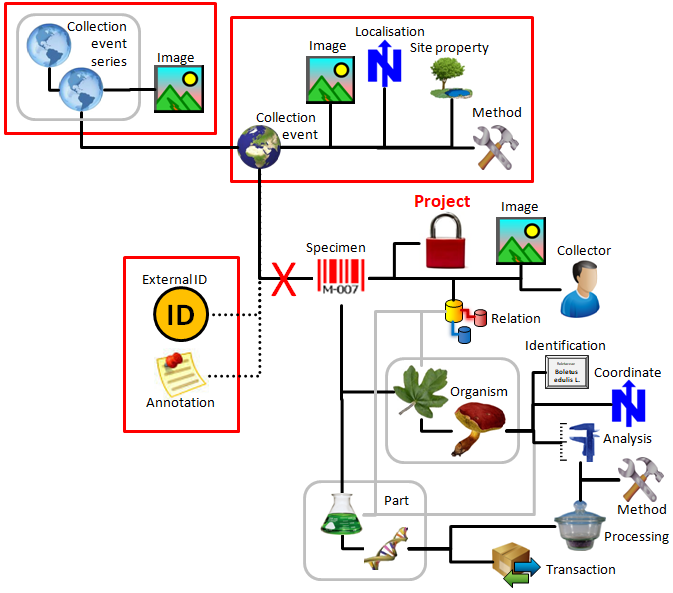
The removal of orphaned event data is described in the Maintenance capters CollectionEventSeries and CollectionEvent.
Provided you have the proper rights you may remove unlinked data sets in the tables CollectionEvent and CollectionEventSeries. To delete events which are not linked to any data in the database use the tab page [Remove unrelated events]. These unrelated data sets may e.g. be derived from specimens which were transferred to another CollectionEvent. Click on the [List unrelated events] button to list all events which are not related to a specimen. The found CollectionEvents will be listed in the upper part of the form. The lower part shows the localisations and the event properties related to these CollectionEvents. These must be deleted first before you can delete the events related to these data sets. Otherwise only the events with no relations to localisations or properties will be deleted.
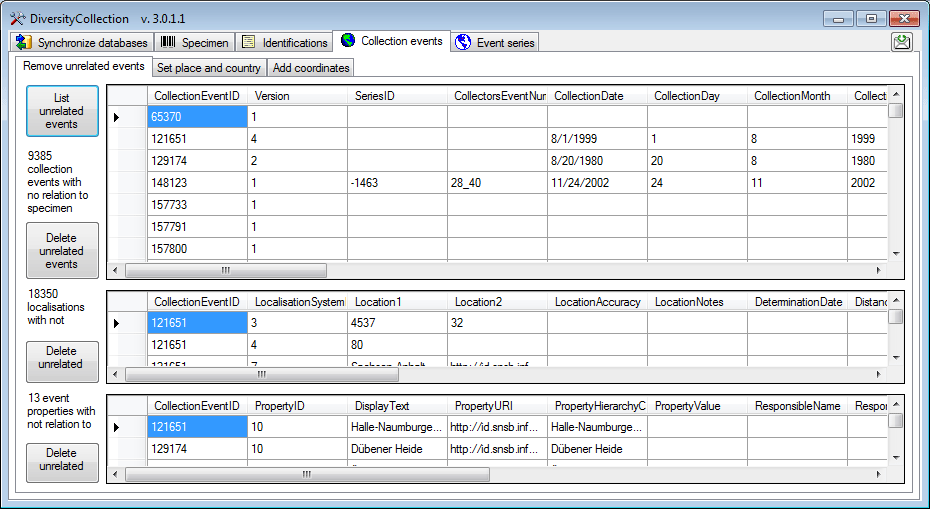
To delete CollectionEventSeries with no relation to CollectionEvents or other event series choose the tab page [Remove unrelated event series]. Click the [List unrelated event series] to list these series and the [Delete unrelated event series] button to delete them.
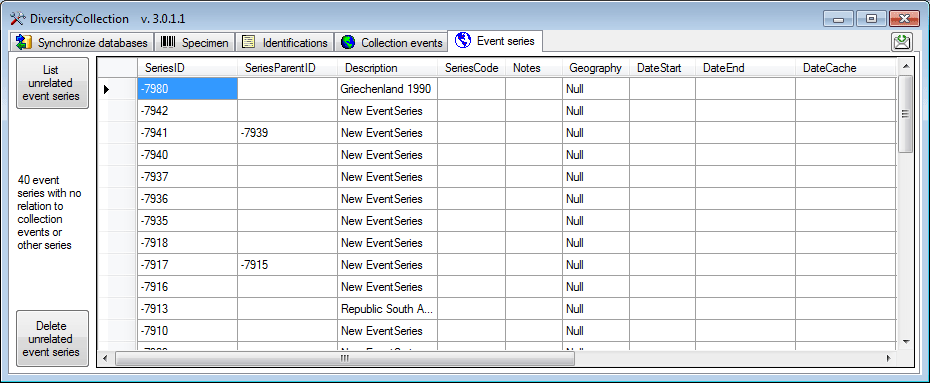
Provided you have the proper rights you may remove orphaned data sets in
the table Annotation. To delete annotations which are not linked to any
data in the database use the tab page 

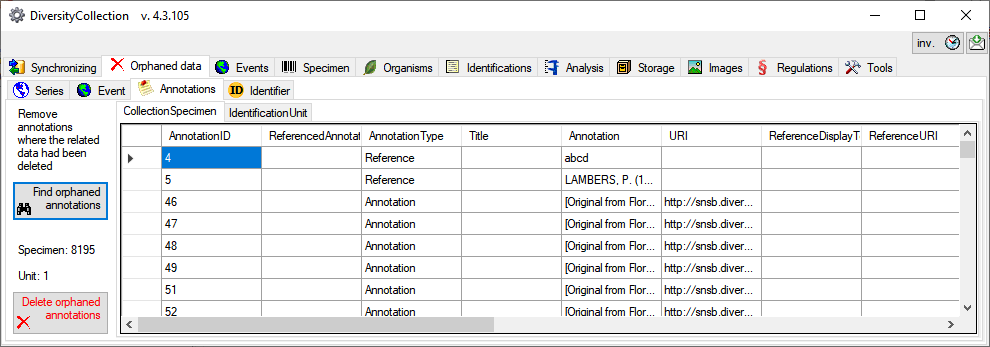
As described for the annoations above you can delete orphaned external
identifier in the tab 


As described for the annoations above you can delete orphaned internal
relations in the tab 


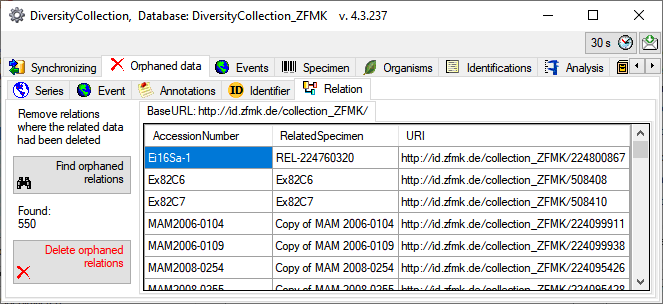
Provided you have the proper rights you can remove orphaned data sets in
the tables CollectionEvent and CollectionEventSeries. To delete events
which are not linked to any data in the database use the tab page




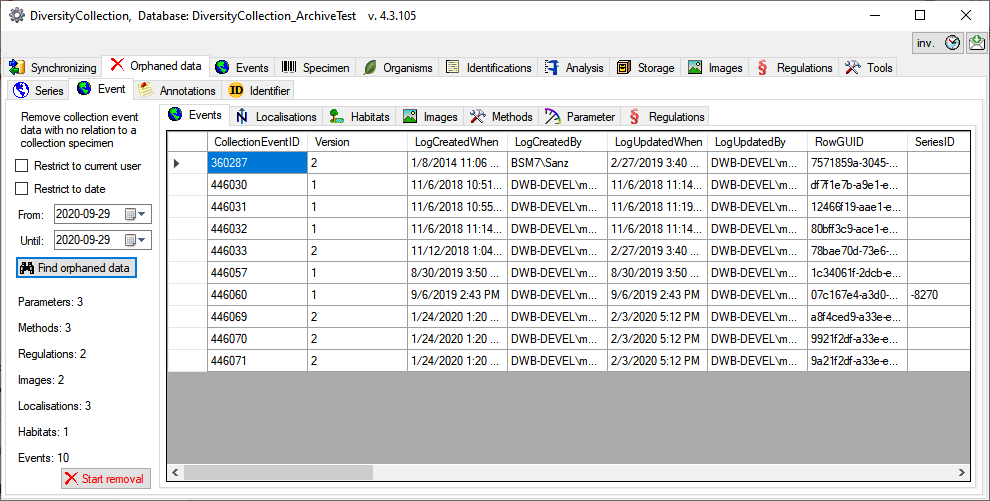
If your data sets contain WGS84 Coordinates, you can use the webservice
www.geonames.org to insert or update the
country, the place or the altitude of your collection sites. Choose the
tab 
| White | The data set will be inserted or changed |
| Red | An error occured |
| Grey | According to the selected option this data set will not be inserted or changed |
| Yellow | The data set has been deselected and will not be inserted or changed |
| Green | The data set has been inserted or changed |

In the first column you can deselect a data set for the update. To
inspect a single data set from the list select it and click on the

As for countries, the places will be listed as shown below.

To insert or update the selected data sets click the Insert places button.

The image above shows the data for the altitude. After the update all updated data sets will be marked green (see below).

If your data contains references to sampling plot coordinates, you can update the locality description according to the name of the sampling plot (see image below). Click on the Start search button to find links to SamplingPlots where the locality description does not correspond to the name of the sampling plot. You can restrict the search to missing locality descriptions and attach the name of the sampling plot to the existing entry in the locality description. Use the Start update button to set the locality description according to your settings and the differences found.
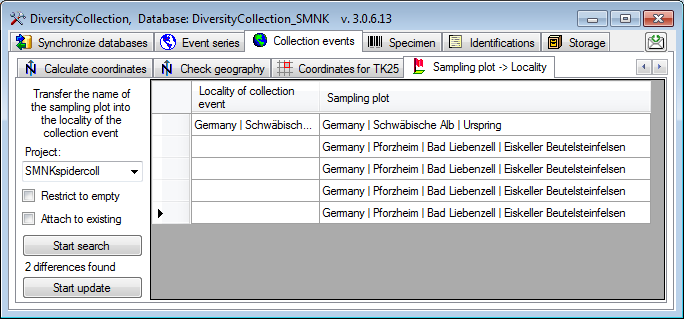
If your events contain methods where parameters for these methods had
been added afterwards, you can add these missing parameters. You may
restrict the search for missing parameters to certain methods and
projects (see image below). Click on the Find differences



If your data contain or needs coordinates, please see the corresponding chapter on adding and calculatingcoordinates.
If your events contain missing or invalid collection dates you may
search for these in the 




To delete CollectionEventSeries with no relation to CollectionEvents or
other event series choose the tab page 



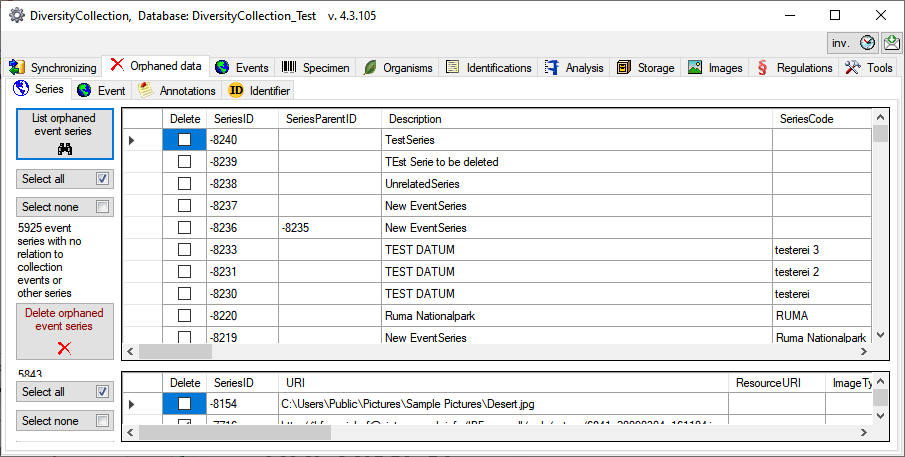
If your data contain coordinates you can add additional coordinates in a
different system for those dataset, where entries of the additional
coordinate system are missing. E.g. you can add WGS84 coordinates on the
basis of Gauss Krueger coordinates. In the 
 button to start the
conversion. If a conversion is not possible, the fields for the target
system will be empty as shown below. The option
button to start the
conversion. If a conversion is not possible, the fields for the target
system will be empty as shown below. The option 

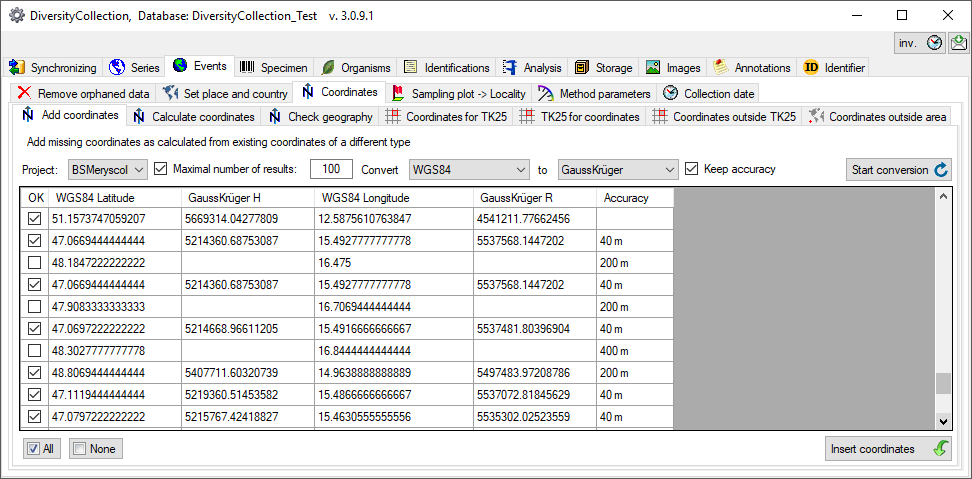
For adding WGS84 coordinates on the basis of existing  UTM entries, you
may have to specify the grid zone if this is missing in the data. By
default the resulting WGS84 coordinates are rounded to 6 places
corresponding to an accuracy of 1 m. In case you want to avoid the
rounding of the calculated values, uncheck the
UTM entries, you
may have to specify the grid zone if this is missing in the data. By
default the resulting WGS84 coordinates are rounded to 6 places
corresponding to an accuracy of 1 m. In case you want to avoid the
rounding of the calculated values, uncheck the 

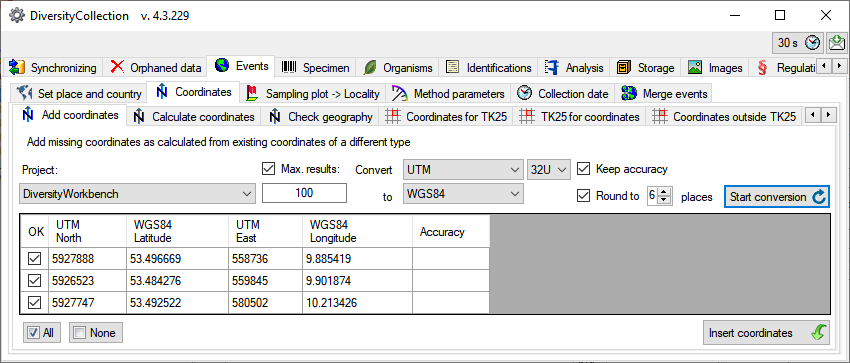
Check the video for an overview regarding UTM:
If your data contain coordinates e.g. written as non numeric entries
like 59°21’W 10°12’S you can try to calculate numeric values from these
entries (see below). Select the project, the maximal number that should
be parsed and the type (currently only WGS84). Then start the conversion
with a click on the start calculation
button. Click the

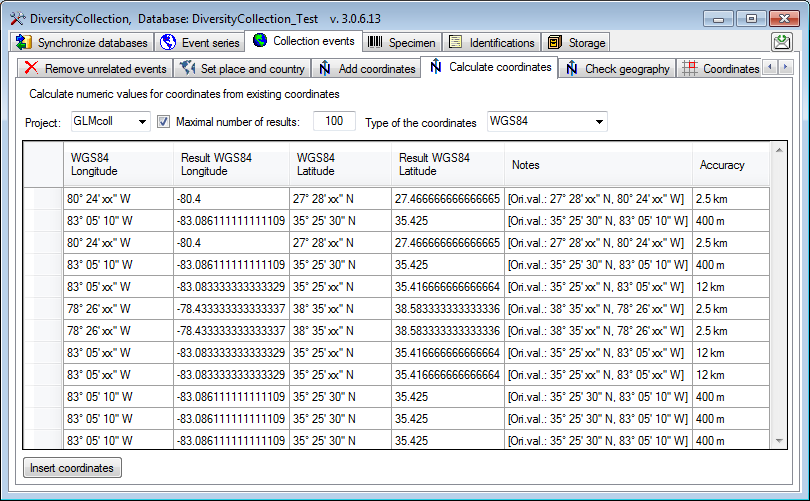
If your data contain coordinates these may be inconsistent between the 3
places the coordinates are stored. To fix these inconsistencies use the
functions showed in the image below and a short tutorial


For comparision of the cache values you may try to use numeric values as base for the comparision.
If your data contain TK25 (= MTB) entries you can try to retrieve the
coordinates and geography for these entries from data in the module
DiversityGazetteer (see below). If the source database is located on a
different server, select the source from the list (for adding source
databases see chapter Connections). As the retrieval
of the geographical data is rather time consuming, you may restrict the
number datasets tested. Choose a project and click on the Find
differences 


If your data contain WGS84 coordinates you can try to retrieve TK25 (=
MTB) entries for these entries from data in the module
DiversityGazetteer (see below). Select the source for the geographical
information. If the source database is located on a different server and
not connected via a linked server, select the source
from the list (for adding source databases see chapter
Connections). As the retrieval of the geographical
data is rather time consuming, you may restrict the number datasets
tested. By default the range for the search is restricted (Lat.: 47.1 -
55.2 and Long.: 6.0 - 15.2) to avoid the inclusion of coordinates where
no TK25 information is expected. Choose a project and click on the
Find missing TK25 



A precondition for the above described handling of the TK25 datasets is the availablity of the corresponding data in the Gazetteer database. The current range is shown in the image below.

If your data contain WGS84 coordinates outside TK25 (= MTB) entries
these can be detected in the Coordinates ouside TK25 part. Choose the
project and click on the Find differences 

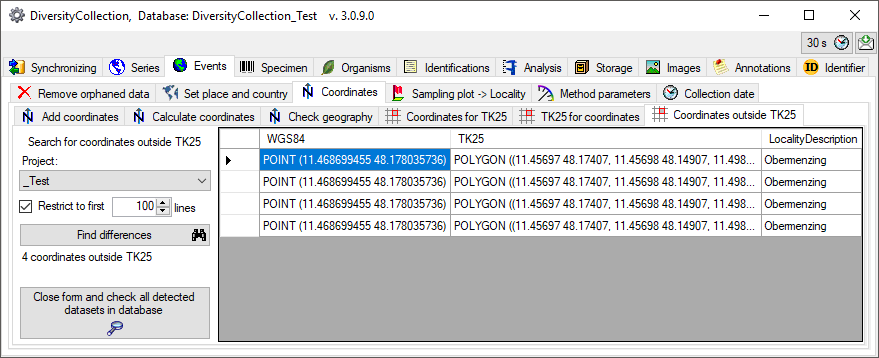
If your data contain coordinates these may be positioned  outside an area
e.g. due to swapping latitude and longitude. You can detect these errors
by comparing all coordinates within a project with an area as provided
by DiversityGazetteer. In the maintenance form choose
outside an area
e.g. due to swapping latitude and longitude. You can detect these errors
by comparing all coordinates within a project with an area as provided
by DiversityGazetteer. In the maintenance form choose


 Coordinates outside area. You
may restrict the search with the
Coordinates outside area. You
may restrict the search with the 



 button to select the area the coordinates
should be compared with. A window will open where you can select among
the areas provided by the DiversityGazetteer database you selected as a
source. Finally click on the Find coordinates outside the area
button to select the area the coordinates
should be compared with. A window will open where you can select among
the areas provided by the DiversityGazetteer database you selected as a
source. Finally click on the Find coordinates outside the area




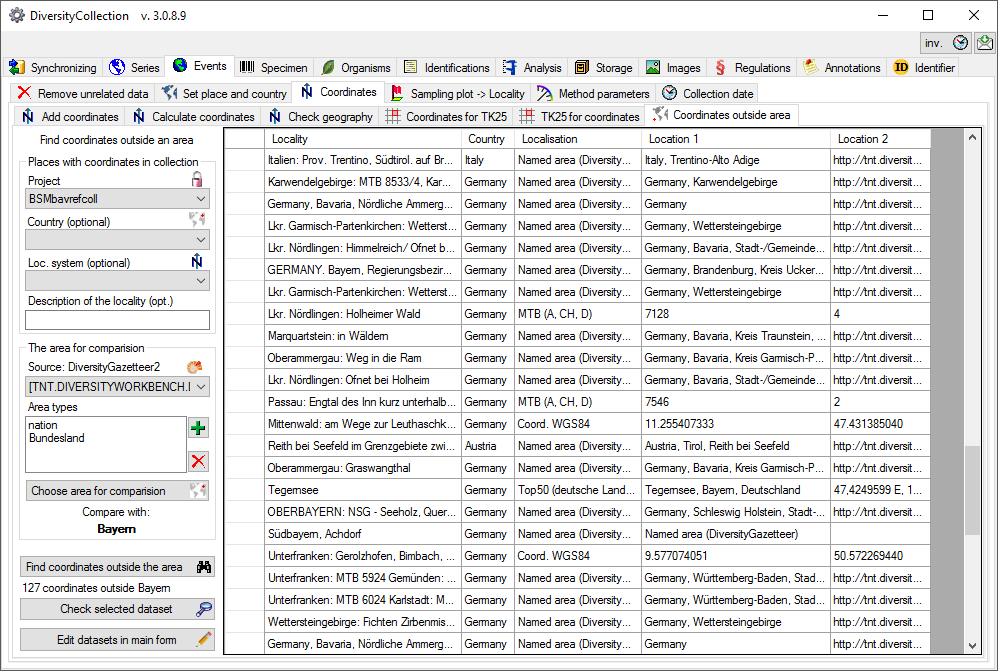
If collection events with equal data should be merged, select the tab

 Merge
events as shown below. You may choose a project, a year, a country and
the maximal number of results to restrict the search. By default all
columns of the table
Merge
events as shown below. You may choose a project, a year, a country and
the maximal number of results to restrict the search. By default all
columns of the table 


 methods and images are included. To find
similar events with different entries in certain parts, you can deselect
those parts where there is no match in the data. To start the query
select a project and click on the
methods and images are included. To find
similar events with different entries in certain parts, you can deselect
those parts where there is no match in the data. To start the query
select a project and click on the 
 top events of the
groups.
top events of the
groups.
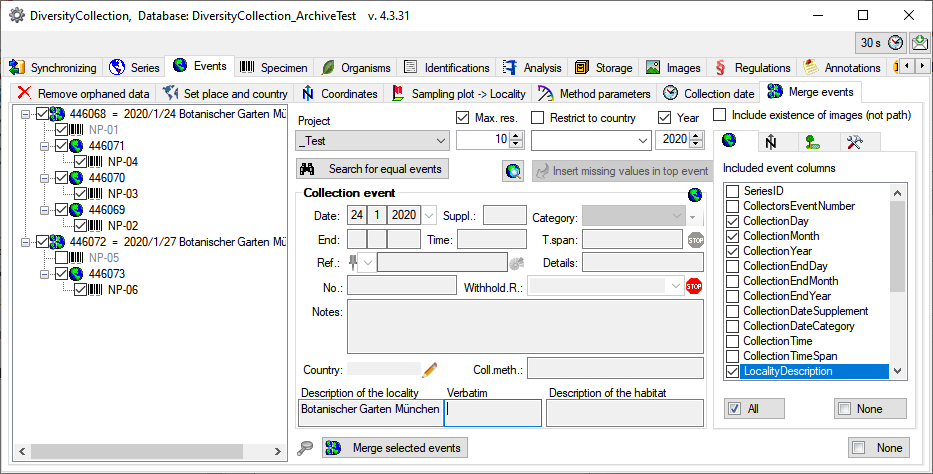
Click on an event to see the details 



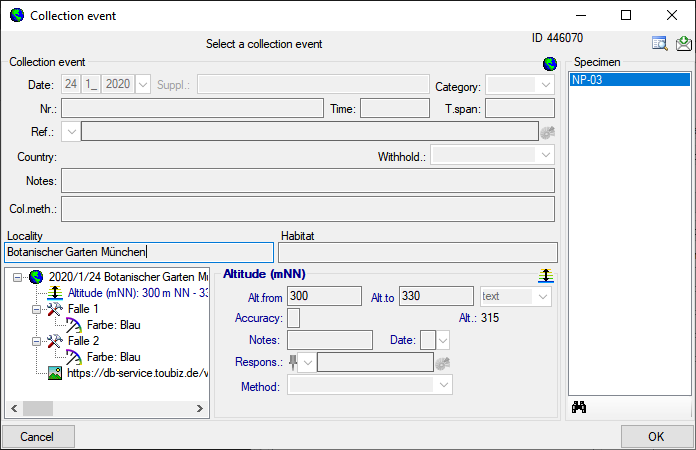
The target of the merge is always the  top
node of a group. To transfer missing data from events linked to the top
event, select a depending
top
node of a group. To transfer missing data from events linked to the top
event, select a depending 

 merge
selected events button.
merge
selected events button.
The database will warn but not prevent you from entering an accession
number several times e.g. via an import. In the main form a duplicateaccession number is indicated with a red background. To
check for duplicate accession numbers choose Administration -
Maintenance from the menu. In the window that will open, choose the
tab page 


The form will list all duplicates found as shown above. To switch to a
data set in the database select it in the table and click on the Close
form and check dataset in database 
 . To list all duplicates in the main form
click on the Close form and check whole list in database
. To list all duplicates in the main form
click on the Close form and check whole list in database



Use the 


To find observations (= organisms without a part in a collection) with
missing retrieval type choose








To print a label for your samples you need to specify which of the organisms in the specimen should be shown on the label. If for any reason the organisms where not included into the parts as shown in the image below, you may do this belated for all data sets for a selected project.

Select the print tab as well as the project and click on the [Check for missing units in parts] button. The missing entries will be listed as shown below. To insert them click on the corresponding button.
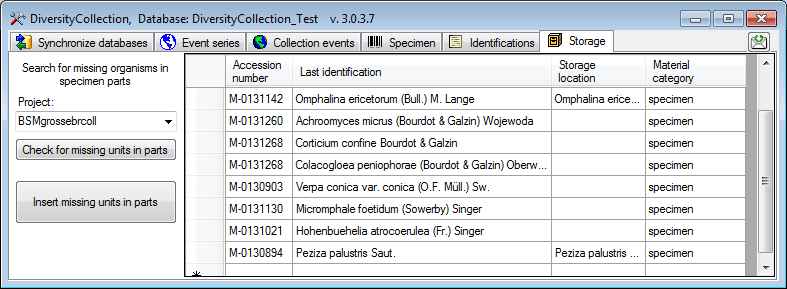
The image below displays the option to synchronize the storage location
with the last identification. Select the project and Search for
differing storage 


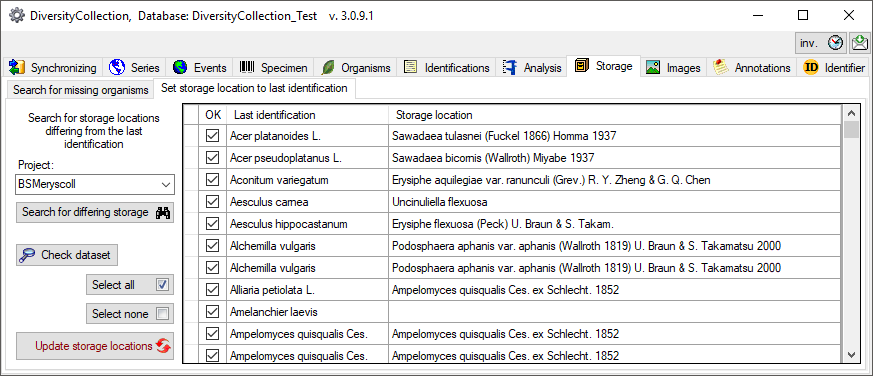
To add a new analysis depending on present entries choose
Administration - Maintenance from the menu. A window will open as
shown below. On the tab page 




The sorting of images may be changed for a whole project. Choose
Administration - Maintenance from the menu. A window will open as
shown below. On the tab page Images select the project for which the
images should be sorted. There are 4 options to sort the images (see
image below). Click on the button 

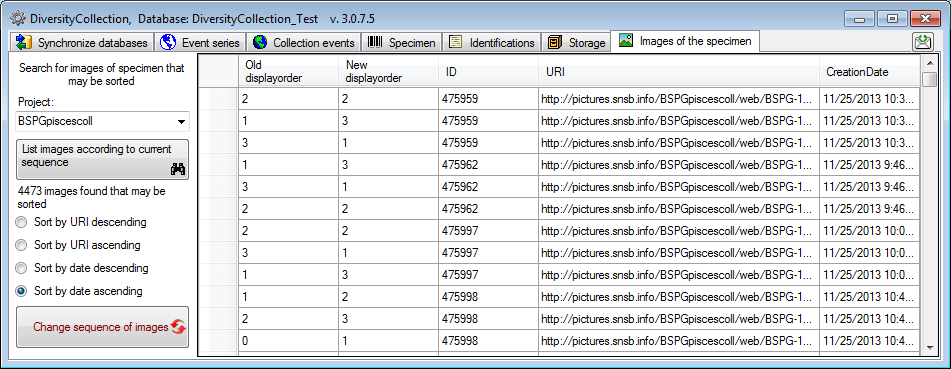
To insert regulations like the Nagoya protocol choose Administration
→ Maintenance from the menu. A window will open as shown below. On
the tab page 

If the data should be withheld from publication e.g. via the cache
database, enter the corresponding withholding reason

Click on the 
With the Start entry of the
regulations 
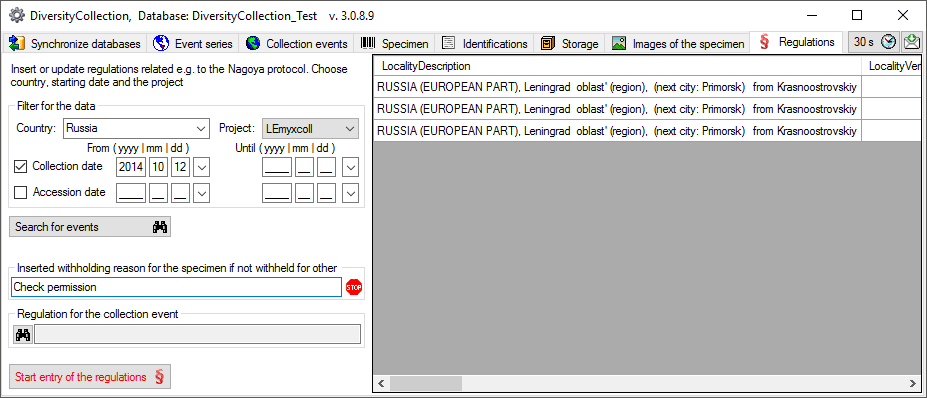
The regulations will be inserted as shown below.

To remove C0 codes from text
columns in the database choose Administration - Maintenance from the
menu. A window will open as shown below. On the tab page


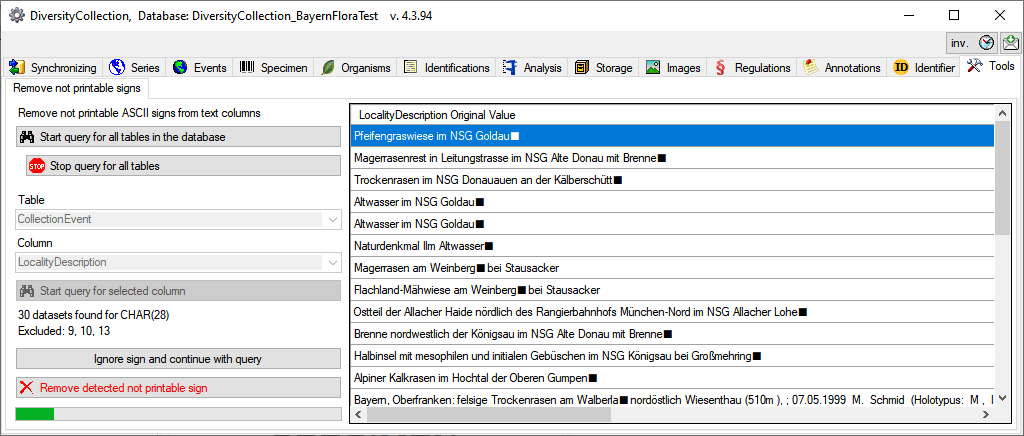
To print a label for your samples you need to specify which of the organisms in the specimen should be shown on the label. If for any reason the organisms where not included into the parts as shown in the image below, you may do this belated for all data sets for a selected project.

Select the print tab as well as the project and click on the Check for missing units in parts button. The missing entries will be listed as shown below. To insert them click on the corresponding button.

To transfer references from deprecated columns in the tables
CollectionSpecimen and
Identification into the new
table CollectionSpecimenReference choose Administration →
Maintenance from the menu. A window will open as shown below. On the
tab page 





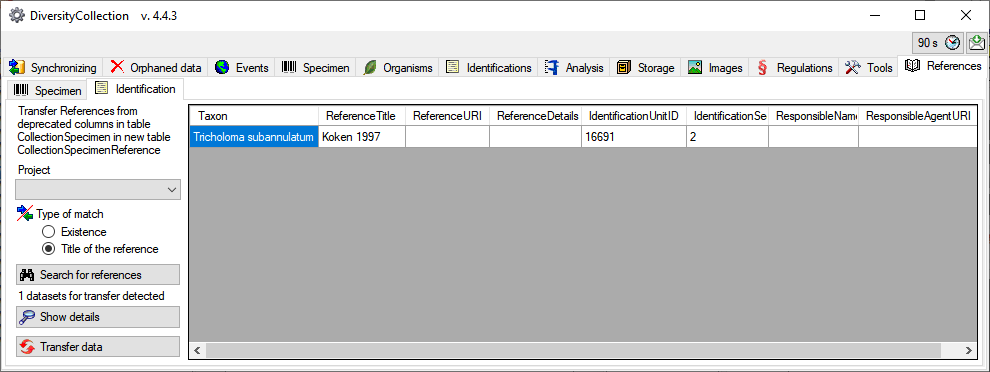


Click on the search button 
